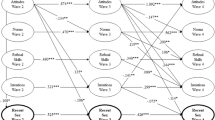Abstract
The present investigation examined the costs and benefits that adolescents perceive for engaging or not engaging in two potentially health-compromising behaviors: underage alcohol use and nonmarital sexual intercourse. A number of hypotheses regarding gender, behavioral status, and grade differences were examined in a sample of over 2400 7th–12th graders. Our hypotheses were more clearly confirmed for perceived costs than for perceived benefits. For both sexual activity and alcohol use, there were strong differences in perceived costs between the two status groups, with nondrinkers and nonsexually active adolescents perceiving significantly more costs to these behaviors. Contrary to our hypotheses, perceived benefits did not discriminate between the two status groups. As was hypothesized, girls generally perceived more costs than did boys for engaging in sexual intercourse and using alcohol; students' perceptions of the costs of alcohol use decreased with increasing grade level. The grade trends concerning the other costs and benefits scales were all complicated by interactions with behavioral status. This study supports the idea that adolescents' perceptions of the costs and benefits of various health-compromising behaviors are related to gender, age, and the behaviors themselves. The findings further indicate that the costs adolescents perceive are more important than the perceived benefits for understanding why some adolescents engage in these behaviors and others do not.
Similar content being viewed by others
References
Baumrind, D. (1987). A developmental perspective on adolescent risk taking in contemporary America. In Irwin, C. E. (ed.),Adolescent Social Behavior and Health: New Directions for Child Development. Jossey-Bass, San Francisco.
Block, J., Block J., and Keyes, S. (1988). Longitudinally foretelling drug usage in adolescence: Early childhood personality and environmental precursors.Child Develop. 59: 336–355.
Brooks, J., Whiteman, M., and Gordon A. S. (1983). Stages of drug use in adolescence: Personality, peer and family correlates.Develop. Psychol. 19: 269–277.
Brooks-Gunn, J. (1988). Antecedents and consequences of variations in girls' maturational timing.J. Adoles. Health Care 9: 1–9.
Brooks-Gunn, J., and Furstenberg, F. (1989). Adolescent sexual behavior.Am. Psychol, 44: 249–257.
Coombs, R. H., and Landsverk, J. (1988). Parenting styles and substance use during childhood and adolescence.J. Marriage Family 50: 473–482.
Emerson, R. (1976). Social exchange theory. In Inkeles, A., J. Coleman, J., and Smelser, N. (eds.),Annual Review of Sociology. Annual Reviews, Palo Alto, CA.
Festinger, L. (1957).A Theory of Cognitive Dissonance. Row-Peterson, Evanston, IL.
Furby, L., and Beyth-Marom, R. (1990).Risk Taking in Adolescence: A Decision-Making Perspective. Carnegie Council on Adolescent Development Working Paper, Washington, DC.
Hofferth, S. L., and Hayes, C. (eds.). (1987).Risking the Future: Adolescent Sexuality, Pregnancy and Childbearing, Vol 2, Working Papers and Statistical Reports. National Academy Press, Washington, DC.
Homans, G. (1974).Social Behavior: Its Elementary Forms. Harcourt Brace Jovanovich, New York.
Inazu, J. K., and Fox, G. L. (1980). Maternal influence on the sexual behavior of teenage daughters.J. Family Issues 1: 81–102.
Jessor, R. (1982). Critical issues in research on adolescent health promotion. In Coates, T. J., Peterson, A. C., and Perry, C. L. (eds.),Promoting Adolescent Health: A Dialog on Research and Practice. Academic Press, New York,
Jessor, R. (1984). Adolescent development and behavioral health. In Matarazzo, J. D., Weiss, S. M., Herd, J. A., Miller, N. E. and Weiss, S. M. (eds.),Behavioral Health: A Handbook of Health Enhancement and Disease Prevention. Wiley, New York.
Kandel, D., and Andrews, K. (1987). Processes of adolescent socialization by parents and peers.Int. J. Addict. 22: 319–342.
Keppel, G. (1973).Design and Analysis: A Researchers's Handbook. Prentice-Hall, Englewood Cliffs, NJ.
Labouvie, E. W. (1986). The coping function of adolescent alcohol and drug use. In Silbereisen, R. K., Eyferth, K., and Rudinger, G. (eds.),Development as Action in Context: Problem Behavior and Normal Youth Development. Springer-Verlag, New York.
Miller, B., McCoy, J. K., Olson, T., and Wallace, C. (1986). Parental discipline attempts in relation to adolescent sexual attitudes and behavior.J. Marriage Family 48: 503–512.
Millstein, S. (1989). Adolescent health: Challenges for behavior scientists.Am. Psychol. 44: 837–842.
Minnesota Department of Health. (1987).Minnesota Adolescent Health Survey. Minnesota Department of Health, St. Paul.
Nye, F. I. (1979). Choice, exchange and the family. In Burr, W. R., Hill, R., Nye, F. I., and Reiss, I. (eds.)Contemporary Theories About the Family. The Free Press, New York.
Office for Substance Abuse Prevention. (1987).Literature Review on Alcohol and Youth. Department of Health and Human Services, Rockville, MD.
Robbins, C., Kaplan, H., and Martin, S. (1985). Antecedents of pregnancy among unmarried adolescents.J. Marriage Family 47: 567–583.
Smith, E., Udry, R., and Morris, N. (1985). Pubertal development and friends: A biosocial explanation of adolescent sexual behavior.J. Health Social Behav. 26: 183–192.
Steinberg, L. (1989).Adolescent Transitions and Substance Abuse Prevention. United States Office of Substance Abuse Prevention, Washington, DC.
Thibaut, J., and Kelley, H. H. (1959).The Social Psychology of Groups. Wiley, New York.
Zucker, R. A., and Harford, T. C. (1983). National study of the demography of adolescent drinking practices in 1980.J. Studies Alcohol 44: 974–985.
Author information
Authors and Affiliations
Additional information
An earlier version of this paper was presented at the annual meeting of the National Council on Family Relations, Seattle, Washington, November 1990.
Received Ph.D. from the University of Wisconsin-Madison in child and family studies. Research interests include adolescent-parent relations and adolescent and adult development.
Research interests include adolescent sexuality and interpersonal violence.
Rights and permissions
About this article
Cite this article
Small, S.A., Silverberg, S.B. & Kerns, D. Adolescents' perceptions of the costs and benefits of engaging in health-compromising behaviors. J Youth Adolescence 22, 73–87 (1993). https://doi.org/10.1007/BF01537905
Received:
Accepted:
Issue Date:
DOI: https://doi.org/10.1007/BF01537905




